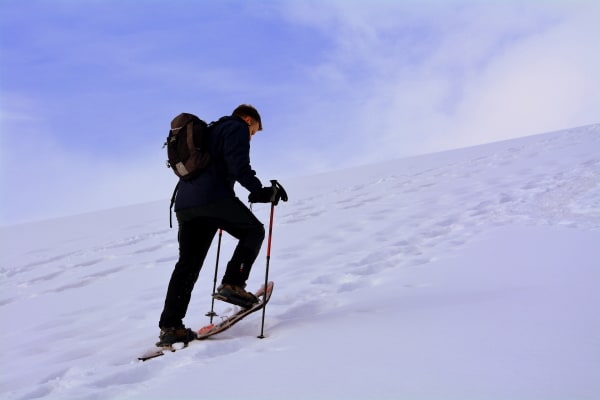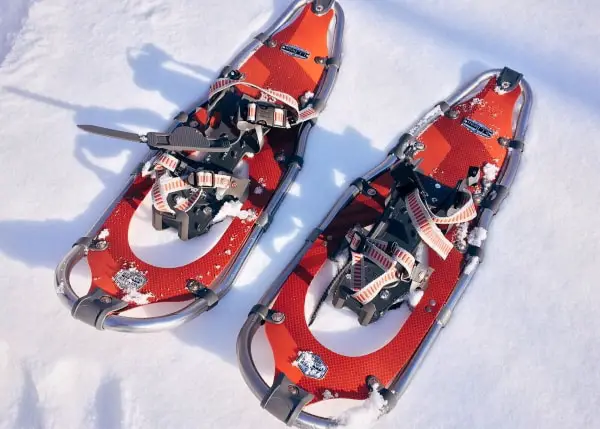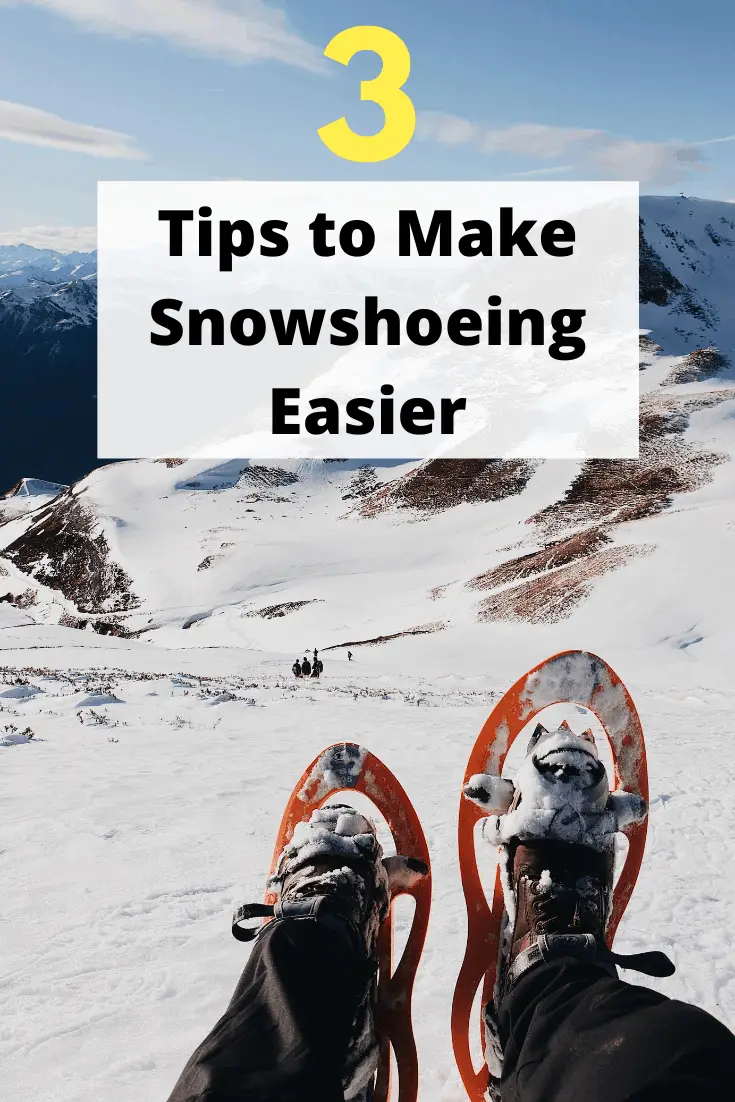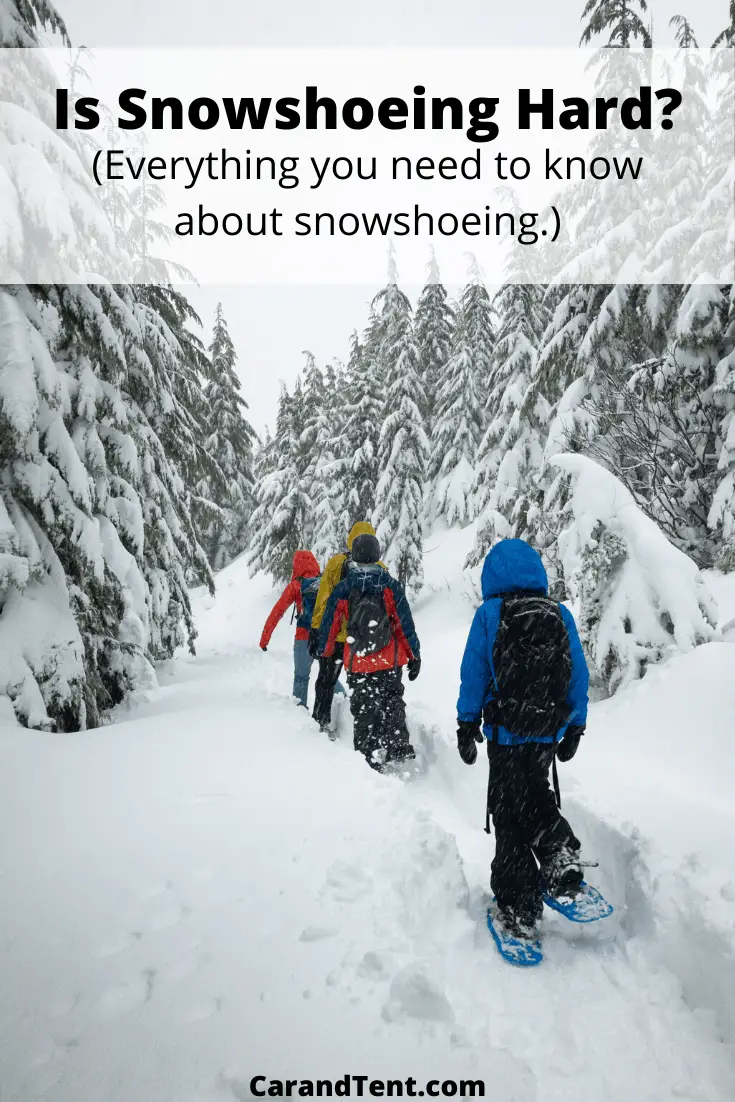
Snowshoeing can be a lot of fun. In fact, more and more people have taken up the sport with each passing year. Some of these people have said that it was easy to get into and others have found it a bit more difficult to get into.
So, how hard is snowshoeing? Snowshoeing isn’t hard to learn but it can be physically challenging. It works your legs as well as your core much harder than regular walking, running, or hiking.
On top of this, you will have to buy or rent some additional gear. Luckily this gear isn’t very expensive and it isn’t very difficult to find.
In the rest of this post, we’ll talk about what you can expect when snowshoeing for the first time.
Table of Contents
Muscles Worked While Snowshoeing
Strap on a pair of snowshoes and you’ll instantly realize that just a few pounds added to each foot can really impact the amount of effort it takes to step forward. Your calves, quads, hams, and glutes will all be put to the test during your snowshoeing adventure.
On top of this, you may find that your joints are put under stress that you normally don’t feel during a typical hike. Typically, your knees, ankles, and feet will get a different workout than usual.
For these reasons, you may want to limit how many hours you spend snowshoeing the first few times you head out. Give your muscles and your joints time to adjust to the additional stress and you’ll be less likely to injure yourself.
Also, keep in mind that your heart and lungs will be working harder than usual during a snowshoe trip. While you might be walking slower than you normally would during a hike, your body will be under greater stress so expect to be out of breath much sooner.
Calories Burned Snowshoeing
Snowshoeing burns a lot of calories. In fact, you can end up burning 300 more calories an hour than you normally would during a hike. Of course, this will vary depending on the type of snow you’re snowshoeing in as well as the speed at which you’re moving.
For more details on how many calories are burned snowshoeing, check out my post on snowshoeing for exercise.
Since you’ll be burning more calories, you may want to consider bringing more food and water with you on your trip. Also, make sure you’re properly hydrated before you head out as it’s often easier to become dehydrated in cold weather versus warm weather.
Snowshoeing When You’re Out of Shape
One of the nice things about snowshoeing is that you get to move at your own pace. This means that even if you’re a little out of shape, you can still go out and have fun snowshoeing.
On the other hand, snowshoeing is physically challenging, so if you have medical issues or are in really bad shape, you may want to consult a medical professional before you head out. Your muscles will be working hard and your heart and lungs will be pumping faster than normal so you’ll at least want to be fit enough to handle this extra strain.
Acquiring Snowshoe Gear
Acquiring snowshoeing gear isn’t very difficult. The only pieces of gear you’ll need are snowshoes, snow goggles, and snowshoe poles.
A beginner pair of snowshoes can be had for less than $100.00 and snow goggles and snowshoe poles can be purchased for less than $30.00 each. If you already have a pair of ski goggles and trekking poles, you can simply use the ones you have.
Snowshoe gear doesn’t have to be purchased right away either. You can rent snowshoe gear from local outfitters as well as big-box stores like REI.

In some areas, you may even be able to get free access to snowshoes. For example, the Jennings Environmental Center in Pennsylvania will lend you a pair of snowshoes for free.
Situations like this might be rare but I’m sure this center isn’t the only place in the country that provides this service. Search hard enough and you may be able to go snowshoeing for free.
On top of the snowshoe specific equipment that you need to go snowshoeing, you may also need to invest in some cold-weather gear. For a detailed rundown on what to wear snowshoeing, see my post titled, “What to Wear Snowshoeing“.
Finding a Place to Snowshoe
The most difficult part of snowshoeing for some people may be in finding a good place to snowshoe. People living in Florida aren’t going to have the same local snowshoeing opportunities that people living in Colorado have available to them.
However, this doesn’t mean Floridians can’t go snowshoeing. This just means that they’ll need to work a bit harder than their northern cousins. For those of you who live in the southern states, consider changing your elevation as well as states and you may find snowshoeing opportunities much closer to home than you thought.
An example of this could be someone living in Baltimore. Baltimore residents only receive an average of 19 inches of snowfall per year. This means that they are very unlikely to get deep enough snow in their area to go snowshoeing each year.
One alternative for these people might be to drive up to New York where snow accumulation is much higher. However, this would be a long trip and they’d have to drive through three different states. Instead, they could head west to Oakland Maryland, where the snowfall averages 127 inches a year.
You’ll find situations like this in every state that has tall mountains so do your research and you might find that there are a lot more snowshoeing opportunities closer to home than you thought.
Mastering the Art of Snowshoeing
The way you snowshoe will depend entirely on the terrain and the type of snow you’re moving through. You’ll need to snowshoe differently through icy snow versus powdery snow and your walking techniques will vary based on whether you’re moving uphill, downhill, or on level ground.
For more details on how to walk with snowshoes, check out the first two tips on my post titled, “15 Snowshoeing Tips for Beginners“. The first tip will tell you why you should never walk backward and the second tip will show you exactly how to safely move through the snow.
How to Make Snowshoeing Easier
If you’ve been snowshoeing and found it a little more difficult than you expected, here are some tips you can use to make it easier.
- Pick a day with good weather.
- Avoid elevation changes.
- Match the snowshoes to the snow.
The Weather
It will obviously be cold when you go snowshoeing, but it doesn’t have to be freezing. It doesn’t have to be overcast or windy either.
Choose a warmer day when the winds are calm and your body won’t have to fight off the cold while you’re snowshoeing. This will reduce the strain on your heart, your lungs, and even your muscles and you’ll have an easier time snowshoeing.
The Elevation
Going uphill in snowshoes can be difficult and your muscles will definitely work harder when you do. However, going downhill can also be difficult on snowshoes as well.
You’ll need to walk slowly and carefully on icy terrain and you’ll need to move swiftly through powdery snow. Both of these snowshoeing techniques will be more difficult than snowshoeing on level ground. To make things easier, just go snowshoeing through terrain without many hills or valleys.
The Snowshoes
There are different types of snowshoes for different types of terrain. Learn how to buy snowshoes that match your particular terrain and you’ll get the most benefit from them. For example, backcountry snowshoes should be used in the backcountry and recreational snowshoes should be used on groomed trails and over easy terrain.
Also, you’ll want to choose snowshoes that are made to support your body weight as well. Snowshoes that are too small won’t give you enough float on the snow and snowshoes that are too large will be harder to walk in.
Final Thoughts
Snowshoeing isn’t very difficult and it has a quick learning curve. However, this doesn’t mean there isn’t anything to learn. Read through the snowshoeing posts on this website, stay safe, have fun, and I’ll see you out on the trails!



